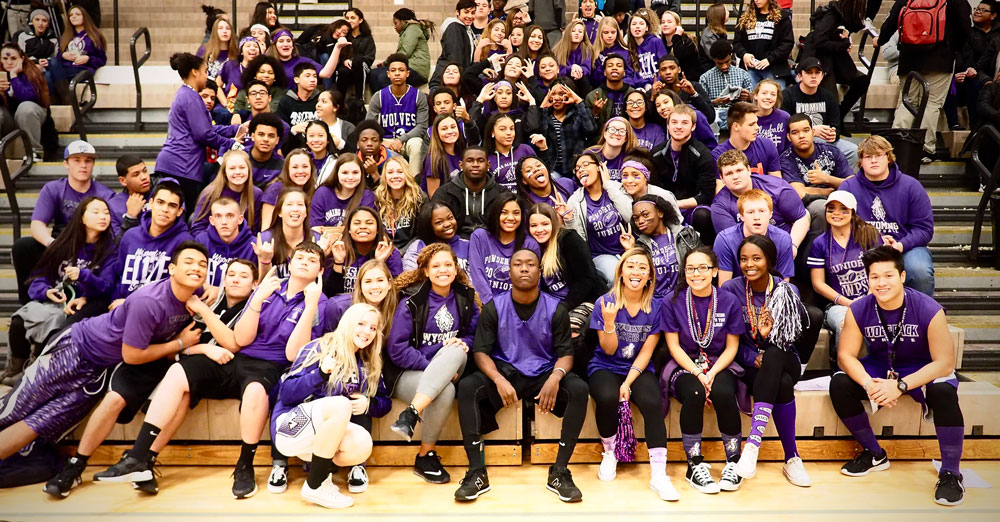All Districts — When Oogie Lamar graduated from Wyoming Park High School in 1985, he was one of about five Black students out of a class of 171, as he recalls it.
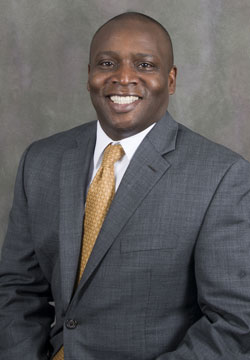
“My family moved to the Wyoming area in the 1970s as my parents had built a house,” said Lamar, who is the Kent ISD director of Adult Education. “I think it was the first movement of minorities that you saw in this area.”
Flipping through that year’s Wyoming Park High School yearbook, other than those few Black students, it is hard to spot students of any other race or ethnicity besides white.
“There were a few students who were Hispanic, but by looking at them you would not know,” Lamar said. “But as far as recognizable names such as Gonzalez, there weren’t any.”
Today, however, if you walk through the halls of Wyoming High School – Wyoming combined its two high schools, Park and Rogers, in 2012 – the faces you’ll see are much more colorful.
According to MI School Data, the state’s official source for PK-12 enrollment information, of the school’s 921 students, about 72 percent are students of color, including over 48 percent Hispanic and nearly 15 percent African American. A little under 28 percent are white.
In Kent ISD public schools, the number of Hispanic students nearly doubled between 2002-03 and 2020-21, going from 9.68 percent of all students to 19.17 percent.
‘Having students who look like you and being able to share the experiences you are facing has been beneficial.’
– Eulaya Powell, Wyoming High School student
Among that 15 percent of Black students is sophomore Eulaya Powell. She delights in the diversity she sees.
“When I walk down the halls, I see groups of Asians, groups of Black students, groups of white students and a mix of those students,” Eulaya said, adding that that includes the LGBTQ+ community.
“There are transgender, gay, biracial couples, which in the past was looked down upon,” she said.
In Wyoming, as in virtually all Kent County schools, students increasingly are learning alongside highly diverse classmates. Many officials call that rich mix of students a plus, including Craig Hoekstra, superintendent of Wyoming Public Schools.
“Diversity is one of the points of pride for our district,” said Hoekstra, a 1990 graduate of Wyoming Park. He calls today’s multiracial student body “one blend of beautifulness.”
Noting the district also has fewer buildings and fewer students than when he was one, with a different community makeup, he said, “Change is inevitable. It’s what you do in response to change.”

Schools Mirror National Changes
Indeed, an overview of the past two decades in Kent County schools shows substantial change in the racial and ethnic makeup of their students, with classrooms looking more and more like American society and the world around them. Kent ISD schools – like those statewide – increasingly see diversity not only in race and ethnicity, but also in culture, national origin, gender and sexual orientation.
A School News Network analysis found that between the 2002-03 and 2020-21 school years – the timespan published on MI School Data – students of color in Kent ISD districts and charter schools increased from 27 percent to nearly 43 percent of total enrollment. The increase closely mirrors a statewide growth among students of color from 27 percent to 35 percent of enrollment.
Total students of color in Kentwood Public Schools increased from from 37.38 % to 71.38 % of enrollment from 2002-03 to 2020-21; in Comstock Park, from 11.64 % to 40.45 %; and in Forest Hills, from 4.19 % to 21.23 %.

Neighboring Ottawa, Muskegon and Allegan counties also have seen their populations diversify, with all three ISDs showing growth of Hispanic students.
These trends reflect a dramatically changing picture of America emerging from recent U.S. Census Bureau reports. Just before the 2020 census, the bureau released its predictions on race and ethnicity that indicated the U.S. population would be more diverse than expected. Those estimates showed that nearly four out of 10 Americans identified with an ethnic group other than white.
The pattern can be seen in schools across the nation as noted by a 2019 Washington Post article, which found increasing numbers of students attending more diverse schools, with many races, ethnicities and countries of origin represented. And the Census Bureau’s 2018 estimates showed that, for the first time, non-Hispanic white residents comprise less than half the population under the age of 15.
“People often hear the word ‘diversity’ and they think that it is going to be in 50 years, but it is actually today,” said Sunil Joy, data research analyst for Kent ISD, who helped provide guidance for this story.

(data from MI School Data, official school information database for Michigan; SNN is using the terminology from MI School to better align with the data)
Hispanics Drive Much Diversification
By far the largest increase in student population is in the Hispanic community. In Kent ISD schools, the number of Hispanic students nearly doubled between 2002-03 and 2020-21, from 9.68 percent of all students to 19.17 percent. Statewide, Hispanic enrollment roughly doubled as well, from 3.79 to 8.44 percent. Asian students also have increased, locally and statewide.
White student enrollment, meanwhile, has declined at both the state and local levels: down from 73 percent to 65 percent statewide, and from 73 percent to 57 percent in Kent ISD. African-American students also have declined slightly both statewide and locally, and now are substantially fewer than Hispanics in Kent ISD schools.
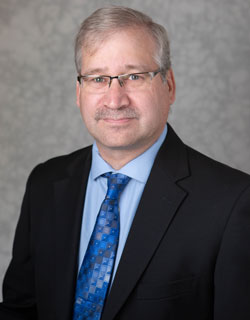
The Hispanic growth in Kent County was boosted during the Great Recession of the late 2000s, said Paul Isely, an associate dean at Grand Valley State University, when many came as migrants to work in fruit orchards and settled out into other sectors like manufacturing and construction. Many were able to buy the more affordable housing offered by developers buying up repossessed homes, Isely said.
“It’s created a large enough group to feel like ‘I have a home here,’” said Isely, who studies demographics as part of the region’s economic development in his role at the university’s Seidman College of Business.
As those families’ students increasingly populate schools – and feel at home there – it’s good for their education and gives parents more reason to stay, he adds: “You’re going to walk into a school and be able to find people who are similar culturally to who you are. That’s going to make it easier to make friends, easier to study.”
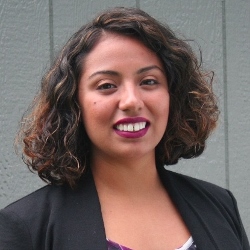
Delia Fernandez, an assistant professor of Latino history at Michigan State University, experienced that cultural affirmation as a student at the former Wyoming Park High School in the early 2000s. Being with a good mix of Latino students boosted her self-esteem and grades – a key social benefit schools provide, she said.
“Latino students are exposed to white, dominant, Anglo culture all the time, everywhere,” said Fernandez, who is writing a book about Grand Rapids’ Mexican and Puerto Rican communities. “But that the schools provide this place where they can be affirmed in their Latino cultures and identities – and white students are exposed to that and see that it’s valuable – that really changes the way they’re going to be able to interact with one another,” and helps Latinos see “that their culture is not marginalized.”
A diverse education environment also benefits students who are growing up in a world that is increasingly more connected, said Christina Arnold, former director of equity and inclusion at Grand Rapids Community College and a diversity consultant.
“The goal in school is to prepare students for not just the local community, but for the world, the global community – and it’s a very diverse world,” Arnold said. “It’s really important for our young people to see others who look like them – and who don’t look like them – not just as peers, but also role models and mentors.
“It’s hard to be what you don’t see.”
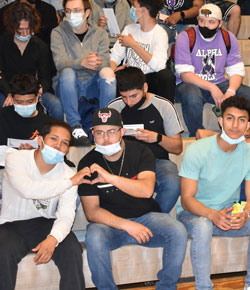
Changes Touch Urban, Suburban and Rural
In Grand Rapids Public Schools, where students of color have increased from 70 to 79 percent, diversity is something the district celebrates and takes pride in, said spokesman John Helmholdt, echoing Arnold’s point.
“You want to prepare kids for the real world and global economy? Welcome to Grand Rapids Public Schools,” he said of the region’s largest district. “Our kids represent 74 countries, 79 different languages spoken. That is a value-added education above and beyond what you can get in any textbook.”
But is not just urban schools such as Grand Rapids, Wyoming or Kentwood that are experiencing the largest increases in students of color. Sharp gains have been seen in Comstock Park (11 to 40 percent), Forest Hills (4 to 21 percent), Kenowa Hills (12 to 31 percent), Kent City (8 to 25 percent) and Northview (6 to 27 percent).
Liz Cotter, deputy superintendent of Northview Public Schools, attributed their growing student diversity largely to the district’s Schools of Choice program, which attracts students from other districts, notably Grand Rapids Public Schools.
Northview also houses the area’s only Deaf and Hard of Hearing program, which draws about 100 students from across Kent ISD, and has about 50 refugee students.
Student clubs at the district such as the Diversity Youth Program and WAVE – Welcoming, Accepting and Valuing Everyone – celebrate the value of interacting in positive ways. The district also works with a local consulting firm that meets monthly with administrators around issues of diversity and inclusion.
In Comstock Park Public Schools, where Latino students increased from 4 percent to nearly 23 percent since 2002-03, the district now has four certified English-language learner staff and three ELL-certified teachers, said Missi McPherson, educational support services coordinator.
McPherson said 230 students currently qualify for ELL services, typically starting in kindergarten. Students’ lives are enriched with 13 different languages spoken in the district and students become more sensitive to biases and better understand white privilege, she said: “It opens up their eyes to their peers.”
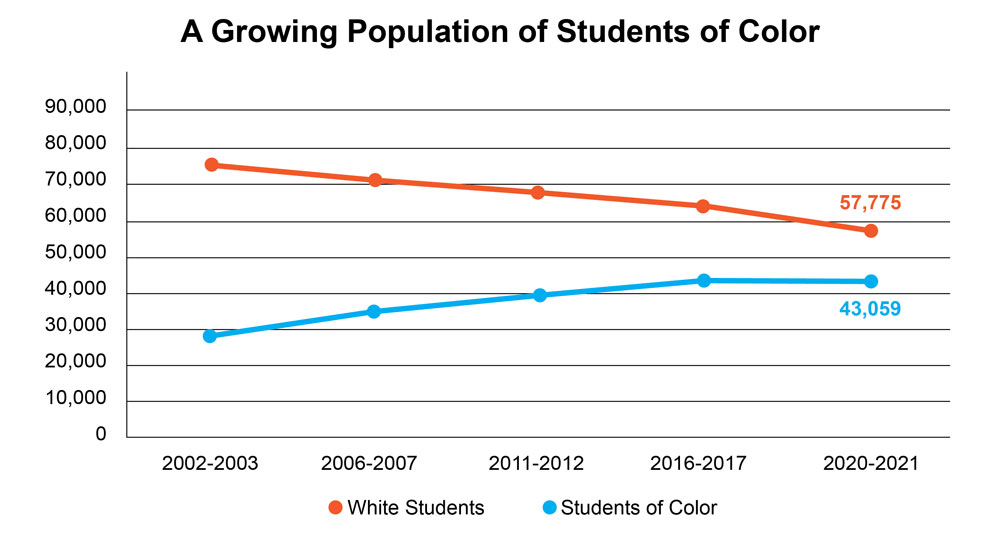
(data from MI School Data, official school information database for Michigan; SNN is using the terminology from MI School to better align with the data)
Making Progress, but Not Enough
Back in Wyoming, Eulaya Powell said student diversity has been a great resource for both the school and for her personally.
“Having students who look like you and being able to share the experiences you are facing has been beneficial,” Eulaya said, adding students shared thoughts and concerns about the 2020 presidential election and the Black Lives Matter movement.
However, while the diversity of the students has greatly increased, the diversity of staff in local schools has not, pointed out Kent ISD’s Joy. Of the more than 25,000 staff members, 86.5 percent are white, about 8 percent are Black, 4 percent Hispanic and less than 2 percent Asian.
‘The goal in school is to prepare students for not just the local community, but for the world, the global community – and it’s a very diverse world.’
– Christina Arnold, diversity and inclusion consultant
School leaders and community groups are working to improve those numbers, including KConnect, a children’s educational and economic advocacy group.
And while he would like to see things move faster, Lamar said he, too, is pleased to see districts are working toward creating a better bridge of understanding about culture, race and identity.
“It is nice to go in and see all those beautiful faces, all the different shapes and sizes,” Lamar said. “It is nice to see the different sexual orientations, the cultural beliefs, the religious beliefs. It makes for a stronger environment and more of an inclusive environment.”
Morgan Jarema, Karen Gentry, Alexis Stark, Erin Albanese and Charles Honey contributed to this story



